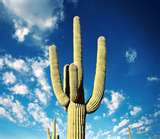The great Sonoran Desert might look barren and lifeless to the unfamiliar eye, but over 540 edible and medicinal plants thrive in this hottest of North American deserts – more than in any other region on earth!
Spanning southwestern Arizona and southeastern California and reaching all the way across the western half of Sonora, Mexico, the Sonoran Desert has been a source of both food and medicine for thousands of years. Even in these days of a grocery store or pharmacy on practically every corner, knowing which desert plants to turn to in times of need, whether for first aid or sustenance, can be reassuring if not life-saving.
This is just a brief introduction to the most common of these desert ‘characters’, all quite fascinating in their own right.
 Saguaro Cactus (Carnegiea gigantea)
Saguaro Cactus (Carnegiea gigantea)
If you’ve ever enjoyed the antics of Coyote and Roadrunner, you’ve probably also seen a cartoon rendering of a saguaro cactus. Found only in the Sonoran Desert, the mighty saguaro (pronounced sah-waro around these parts) is the most recognizable desert plant and can reach heights of up to 50 feet and live to be over 200 years old.
Once a year, in June and July, the saguaro bears fruit; at the top of the cactus sprouts a round, pinkish-red artichoke-looking fruit rich in vitamins A and C and bursting with edible pulp and seeds, with a taste slightly reminiscent of strawberries. The Tohono O’odham (Papago) people of southern Arizona share a long and strong bond with the saguaro, and have been harvesting its fruit (which they call bahidaji) to make syrup, jam and ceremonial wine for centuries.
For the desperate desert wanderer, reaching these tantalizing gems can be a bit tricky but here’s a handy tip: when in a bind, use the spines of a downed saguaro to knock down these hard-to-reach fruits.
Related Articles:
Tohono O’odham Fruit Harvest
Saguaro Fruit Info & Recipes
 Prickly Pear (Opuntia engelmannii)
Prickly Pear (Opuntia engelmannii)
There are 12 species of fruit-bearing prickly pear, but if you happen to run across one in the Sonoran Desert, you’re probably looking at Englemann’s Prickly Pear. Prickly Pear is nearly as unmistakable as the Saguaro, albeit closer to the ground. It’s paddle-shaped pads (or nopales) are usually about the size of your hand, and its round, globe-like fruits (tunas) come into season in late summer or early fall, ready to pick when they turn a deep red or purple.
Both the fruit and the inner flesh of the prickly pear pads are edible. Be careful when harvesting the fruit; it’s covered in invisible hairs that pack a mighty sting and are nearly impossible to extract from your hand – believe me, I found this out the hard way…
The pulp and juice of the prickly pear have been used traditionally to soothe an inflamed digestive tract. Prickly Pear also possesses blood-sugar balancing properties, which might make it helpful for those with diabetes, and may have even protected against this common modern disease when used traditionally. The pads can be sliced open and placed on burns, wounds or inflamed skin to help soothe inflammation and promote healing.
Related Articles:
Harvesting & Processing Prickly Pear
Prickly Pear Recipes
 Creosote (Larrea tridentata)
Creosote (Larrea tridentata)
Creosote, also called greasewood or chaparral, thrives at elevations up to 5000 feet, and can be found throughout the desert Southwest. Its diminutive yellow five-petaled flowers are most prevalent in the spring, but creosote often flowers throughout the year. For us desert dwellers, the first sign of rain is not the kiss of a random raindrop on the skin, but the slight whiff of that ‘desert rain’ smell characteristic of creosote when the rain falls on its resin-laden leaves.
This same sticky resin that coats the leaves serves as a growth inhibitor to surrounding plants, which is why you’ll see few plants gathered around the base of a creosote bush. Creosote is purportedly the oldest living plant, as each individual creosote bush in a given area is actually an offshoot and genetic clone of a mother root, which can be up to 10,000 years old. The most famous mother root, ‘King Clone’ in California, is over 11,000 years old.
Traditionally, creosote served as a veritable desert pharmacy for the inhabitants of the Sonoran Desert, who used it to treat everything from lung congestion to cancer. Unfortunately, in this day and age of government regulation, countless warnings alert us that creosote is potentially a very dangerous plant, despite thousands of years of traditional use.
Related Articles:
Creosote Tea
Medicinal Uses for Creosote
FFVK7CB9EFS6
